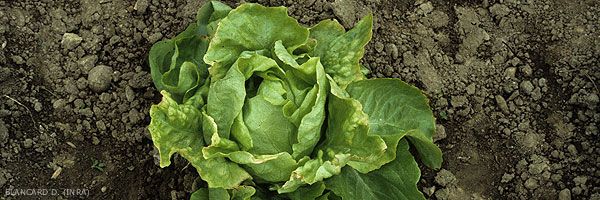
Cucumber mosaic virus (CMV)
Cucumber mosaic virus
- classification : Bromoviridae, Cucumovirus
The cucumber mosaic virus (CMV) is seriously affecting many cultivated species on all continents; its incidence in field lettuce cultivation appears to be very variable. In the northern regions of Europe (Great Britain, Germany, Belgium), it is considered to be a serious virus affecting yields by 10 to 40% depending on the variety. This is also the case in the state of New York, in the United States, where it can cause significant losses in fall crops. In other European countries, such as France, Spain or Italy, where the virus is extremely common in market gardening areas, the damage caused to lettuce is considered relatively low. It is often isolated from all types of lettuce during the summer, but during this season it does not cause very marked symptoms other than a few mottling and reduced growth. Also, its impact may be underestimated. When the day / night temperature contrasts are greater, as in an autumn crop, the symptoms are more pronounced. This may result in a decrease in the number of salable plants.
Mixed CMV-LMV infections are common; in this case, more serious alterations and stunting are observed than during mono-infection with one or other of these viruses (figure 1).
 |
 |
| Figure 1 | Figure 2 |
CMV is a ubiquitous and highly polyphagous virus (Figure 2). It has the largest range of hosts listed. It very seriously affects field vegetables, in particular cucurbits, but also tomatoes, peppers, spinach and celery. A large number of strains have been described on the basis of biological properties (symptomatology, thermosensitivity). There are two main groups of serotypes. Some isolates have a satellite which can modify the expression of its symptoms on some hosts.





